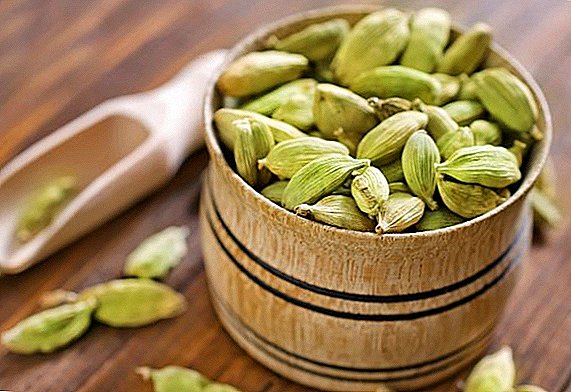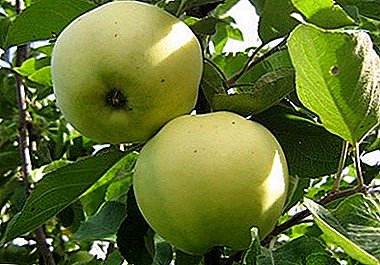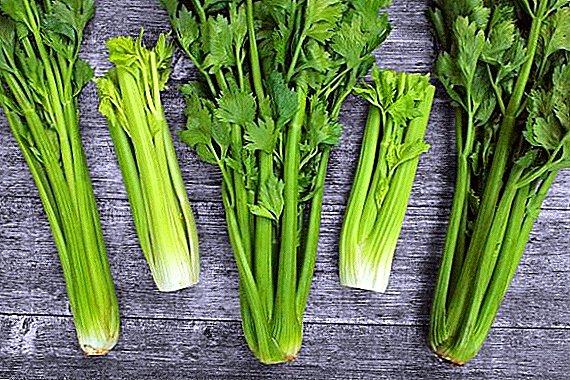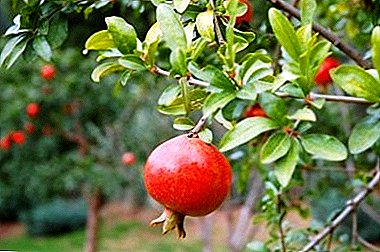 Growing geese is a profitable, low-cost and relevant direction in modern agriculture: with a relatively small financial investment, you can get high-quality goose products: meat, eggs, fat and fluff. The Rhine, or German Geese is one of the best modern breeds of domestic birds, with excellent growth and egg production. On how to properly grow such geese, as well as a description of the breed - more in the article.
Growing geese is a profitable, low-cost and relevant direction in modern agriculture: with a relatively small financial investment, you can get high-quality goose products: meat, eggs, fat and fluff. The Rhine, or German Geese is one of the best modern breeds of domestic birds, with excellent growth and egg production. On how to properly grow such geese, as well as a description of the breed - more in the article.
Breed history
This breed was bred by an artificial, selective method as early as the 40s of the last century: a snow-white Rhine bird appeared as a result of experimental mating of some species of Emden breed. Breeding took place in the vicinity of Düsseldorf, located near the Rhine River - hence the name of the breed.  Within 20 years from the time of hatching, the Rhine breed, thanks to its excellent production performance, spread throughout the poultry farms of almost the whole of Europe - in the USSR, the first specimens of the German goose were imported in 1969. By 1980, the number of these birds in the state was more than 35 thousand, and today the total population in Ukraine and Russia is over 600 thousand.
Within 20 years from the time of hatching, the Rhine breed, thanks to its excellent production performance, spread throughout the poultry farms of almost the whole of Europe - in the USSR, the first specimens of the German goose were imported in 1969. By 1980, the number of these birds in the state was more than 35 thousand, and today the total population in Ukraine and Russia is over 600 thousand.
Did you know? Goose domestication occurred in Egypt more than 4,000 years ago - it is one of the first domesticated domestic animals (second only to chicken and cat).
Exterior
The Rhine Goose is a bird with excellent appearance: this breed often wins prizes at international exhibitions of agriculture and animal husbandry.
- Color. A characteristic feature of this German bird is the snow-white, with a silver tint, the color of feathering, which does not change even during the process of molting. This distinguishes the Rhine goose from its other relatives, which are able to change color depending on weather conditions or the period of the year.
- Pooh. High quality: feathers are sturdy and tight to the body.
- Torso. The bird has a tightly knit, small body and a developed musculature.
- Back. Round, slightly inclined to the back of the body, from which it smoothly passes into the tail. It has a small bump.
- Brisket. Broad, well developed, muscular, low.
- Stomach. Soft, convex, with a small amount of fat. At the bottom of the abdomen is a double fold.
- Wings. Set high, completely covering the back. Covered with thick soft plumage.
- Shin. Well developed, it closes to the middle with spinal plumage.
- Head. Relatively small, regular form. Located on a small strong neck.
- Eyes and beak. The bill, like the webbed feet, is bright orange in color. The eyes are small, round, uniform dark blue color.

 Unlike its direct ancestor, the Emden goose (whose wild ancestor, by the way, is the swan), the Rhenish breed has more compact and harmonious dimensions: the weight is moderate, and the neck length and brisket height are distinguished by small parameters.
Unlike its direct ancestor, the Emden goose (whose wild ancestor, by the way, is the swan), the Rhenish breed has more compact and harmonious dimensions: the weight is moderate, and the neck length and brisket height are distinguished by small parameters.
Important! Defective birds of the Rhine are those geese that have a high body, too long neck, pointed tail and dark feathers on the wings - such individuals are usually rejected in infancy.
Performance Indicators
The popularity and prevalence of this breed of geese led not only to excellent external data, but also to high productive indicators.
Dynamics and live weight of the gander and goose
Representatives of the German breed are characterized by precocity: within 2 months the young bird reaches the parameters of an adult individual, and by 3 months it begins to accumulate fat. Such rapid growth is very much appreciated by the poultry farmers, because already from the 8-week-old bird you can get excellent meat in its taste parameters - its weight by this age is already about 4 kg.  Adult goose is able to gain mass up to 7 kg, but the geese are lighter: their maximum weight is about 5.5-6 kg. The fatty liver of such geese is especially nutritious: the mass of the liver of an adult individual is not less than 450 grams.
Adult goose is able to gain mass up to 7 kg, but the geese are lighter: their maximum weight is about 5.5-6 kg. The fatty liver of such geese is especially nutritious: the mass of the liver of an adult individual is not less than 450 grams.
Fully ripening of the Rhine bird ends after 12 months from the moment of birth: at this age the geese can already lay eggs.
Did you know? Geese are monogamous birds: they choose their only partner for life. In the case of the death of the halves, the bird may be in a state of mourning for several years, avoiding contact with the opposite sex.
Average annual egg production
The rate of formation and production of eggs of German geese is also characterized by high rates: up to 50 eggs per year, each of which weighs at least 160 grams.  Despite such egg production, the brood of young stock is only about 70%: this breed has a weak incubation instinct, which somewhat reduces the birth rate of the goslings (in comparison, for example, with the Kuban or Solnechnogorsk breed).
Despite such egg production, the brood of young stock is only about 70%: this breed has a weak incubation instinct, which somewhat reduces the birth rate of the goslings (in comparison, for example, with the Kuban or Solnechnogorsk breed).
Find out when geese start to fly at home, as well as how to grow goose in an incubator, determine the sex of geese, slaughter and cut the goose.
Feeding ration
The Rhine breed is distinguished by unpretentiousness and illegibility in food: it is based on fresh or dried grass.
Young
At the stage of the formation of the body, young birds need careful selection of the diet: for active growth and weight gain, they need some minerals and vitamins. For this purpose, they are fed with succulent fodder, fresh cereals, crushed corn cobs, cabbage and beets. As a calcium supplement, crushed eggshell is added to the main feed once a week. At the same time the daily rate of food of a young goose is up to 1 kg per 1 individual - and most of this diet is fresh or dried grass.  A full ration includes the provision of poultry with enough clean water: the young goose can drink up to 1 liter of water per day.
A full ration includes the provision of poultry with enough clean water: the young goose can drink up to 1 liter of water per day.
Check out the breeds of geese for home breeding: Danish legart, Kholmogory, Tula, large gray.
Adults
From the age of 4 months, the handsome Rhine man does not need additional feedings - he is content with fresh and dry grass (in the ratio 80:20). The average amount of grass consumed per day by an adult gander reaches 2.5 kg.
Important! A full and balanced diet of the Rhine birds can easily provide for themselves: for this they need to provide daily long-term walking on pastures with juicy grass.
Conditions of detention
German beauties also do not need special conditions: they are naturally strong immunity and frost resistance.
Nevertheless, for the best growth and egg production, it is necessary to provide the most comfortable conditions:
- Room: the house in which the goose settles for the night must have wooden flooring with sturdy planks. Although the bird is frost-resistant, it is sensitive to drafts - therefore it is important to exclude the gaps and holes in the floor and walls of the house. For additional insulation (especially in the winter months) the floor is covered with a small layer of straw. The bird does not need a lot of space, but the size of the house should not be less than 0.5 cu. meters per 1 goose.
- Temperature: goose feels great at temperatures from 5 to 24 ° C. At higher temperatures, the bird may experience lethargy - to avoid this, you must provide constant access to the water source, as well as equip a bath for swimming. When the temperature drops below 5 ° C, the house is insulated with straw.
- Walk: The health of the bird mostly depends on the duration of its daily walks. Ideally, the Germanic handsome should be in the pasture all daylight hours, and only return to the house for the night for the night. If you deprive the geese of the possibility of walking, they will start to hurt - even with a full and balanced diet.
- Water treatments: the goose is a clean bird who likes to clean feathers regularly and take a bath. The best option for committing water treatments will be a small body of water: a pool, pond or stream. If it is not possible to provide geese access to a natural stream, a bath should be installed on the pasture territory (a small tank for bathing children will also fit): you should change the water in it every 3-4 days, and equip the bath itself in a place protected from sunlight avoid blooming water).
- Inventory: feeding trough, drinking bowl and nest for geese are the obligatory attributes of a proper poultry house. It is best to use a wooden trough and a metal drinker - they will last as long as possible. Wooden baskets, drawers or plywood trays can act as a nest - one nest for 2-3 geese will suffice. It is best to equip them 4-6 weeks before the start of the egg-laying period: this way birds will get used to these items and will be able to use them for their intended purpose.



Did you know? Geese are champions in the field of longevity: for example, the goose of the Vladimir breed can live 35-37 years.
Video: geese of the Rhine breed
The Rhine geese are a popular breed of poultry that is actively grown in Western Europe, Ukraine and Russia. Excellent meat qualities, clean fur and high growth rate of young animals have led to the rearing of this bird on an industrial scale - as an excellent source of meat, fluff, high-quality fat and liver.












